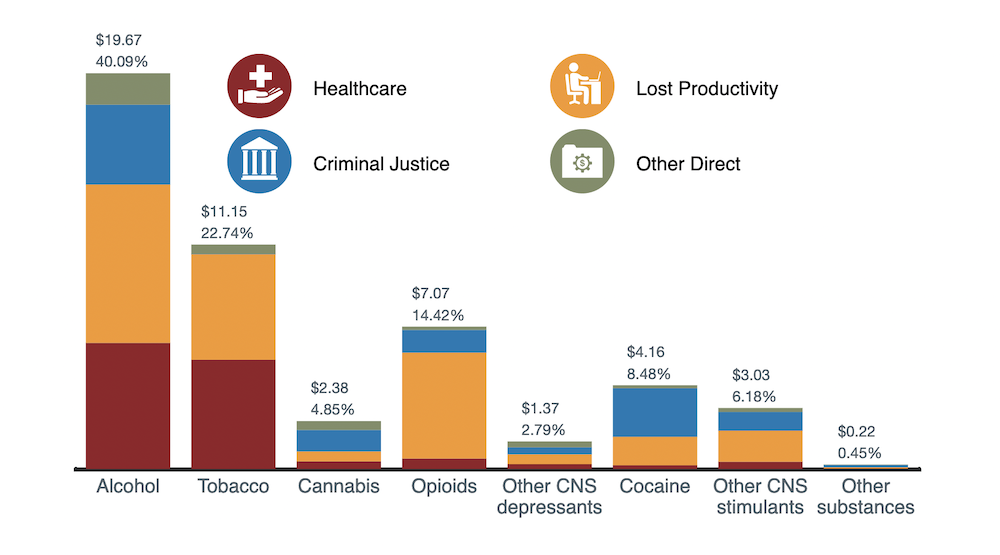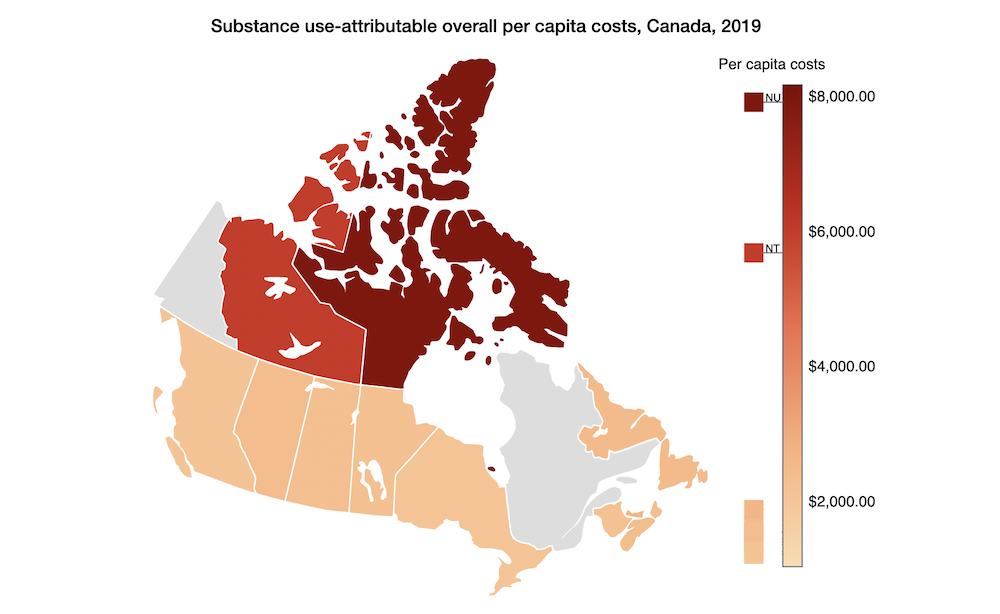Harms from substance use cost Canada $49 billion in 2020, with almost two-thirds of that linked to alcohol and tobacco use, according to the Canadian Substance Use Costs and Harms report with collected data from 2007 to 2020.
The report from the Canadian Centre on Substance Use and Addiction and the University of Victoria’s Canadian Institute for Substance Use Research found alcohol and tobacco use consistently account for the highest economic costs in terms of lost productivity at work (which includes the number of work years lost to substance-use related death or disability), health care and criminal justice costs.
But the recent report found the highest rate of increases in costs was due to opioids and stimulants, like methamphetamine, with the toxic drug supply killing more and more young people and becoming more dangerous during the pandemic.

In B.C., 1,773 people died of toxic drug poisoning in 2020, compared to 987 the year before, and this number rose to 2,293 in 2022. Across Canada the number of opioid toxicity deaths rose to 20 per day last year — double the rate in 2019.
The report sets the dollar amount of opioid and stimulant use at $14.3 billion in 2020, based on health care, lost productivity and criminal justice costs.
“It's almost a bit crass to talk about the harms of substance use in terms of dollars, but on the other hand dollars are like a common denominator that we all understand,” said Adam Sherk, one of the authors of the report.
“It allows us to see which substances are causing most harm in our society so that we can think about policies and practices to address them. The harms themselves, what we experience as people, underlie these dollar estimates.”
Substance use-related costs were by far the highest in Nunavut and Northwest Territories, thousands of dollars higher per person than other provinces and territories in 2020.

Different approaches for different substances
Using data and studies from national and provincial organizations like Statistics Canada, the BC Coroners Service, Health Canada and the Canadian Institute for Health Information, Sherk and his co-authors found that reducing the economic and human costs of different substances will require different solutions.
Addressing harms associated with alcohol use, Sherk explained, needs a separate range of tools than illicit substances like opioids and stimulants because alcohol is legal and available in far greater quantities than any other substance on the market.
Alcohol-induced deaths rose sharply during the pandemic, with 3,790 deaths in 2020 and 3,875 in 2021, compared to 3,200 in 2019 according to StatsCan. Harms associated with its use could be reduced by following the model used to decrease tobacco use.
Though tobacco use continues to incur the second-highest overall costs measured in the report, health care and lost productivity costs associated with tobacco dropped steadily between 2007 and 2020.
According to the report, strategic policies — like labelling requirements to display health advisories and advertising limitations — have worked to slowly cut down the amount of tobacco-related health issues in Canada.
These policies have also been deployed in the rollout of cannabis products after legalization, but haven’t been updated for alcohol.
“We would certainly suggest at the very least having a cancer warning on alcoholic packages,” Sherk said, echoing the Canadian Centre on Substance Use and Addiction report that called for new guidelines for alcohol use. “Removing super cheap products from the marketplace — that's something that was done with tobacco and could be done with alcohol as well.”
On the other hand, since opioids and stimulants are illegal and increasingly toxic in the street supply, Sherk said, the first step is to remove people from harm by expanding access to safer prescribed alternatives to toxic street drugs, opening more supervised consumption sites and employing other harm reduction measures.
This is the third time the long-term project has been updated to include new data over the years. It will continue to operate as long as it receives Health Canada funding.
For its next report, researchers predict they’ll uncover even higher costs due to cancer, mental health and behavioural disorders, and other substance-use related health conditions that could have been mitigated by early intervention care — services that were reduced during the pandemic as health resources were diverted.
“There's a lot of economic and social trauma happening to all of us, particularly people experiencing substance use disorders, because of the pandemic itself shutting everything down,” Sherk said. “Use went back up and the safety went down, the harm of use went back up.”
The purpose of the study is to offer guidance and data to policymakers and public health leaders, but its findings can be used by private players as well.
For their part, employers can help mitigate lost productivity costs due to substance use by providing good benefits packages that include paramedical and mental health services as well as long- and short-term disability benefits, Sherk said. ![]()
Read more: Health
















Tyee Commenting Guidelines
Comments that violate guidelines risk being deleted, and violations may result in a temporary or permanent user ban. Maintain the spirit of good conversation to stay in the discussion and be patient with moderators. Comments are reviewed regularly but not in real time.
Do:
Do not: